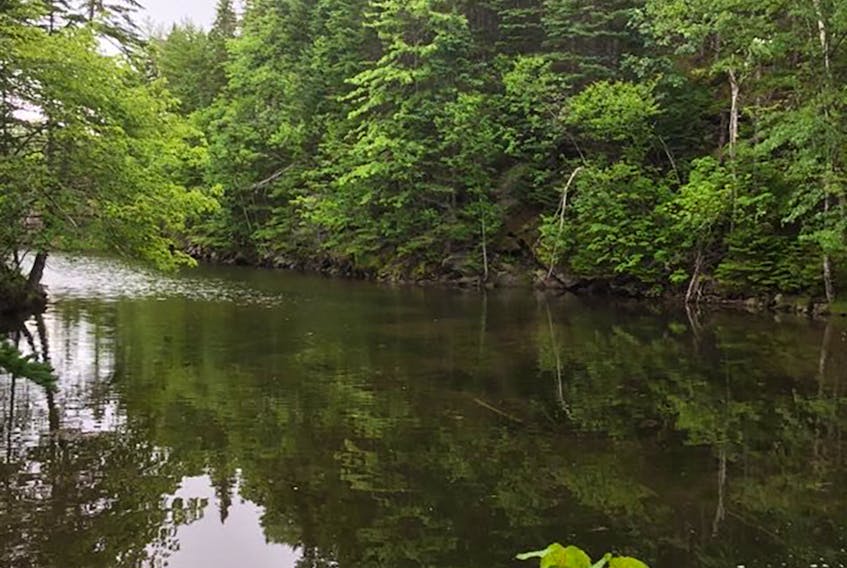Years ago, while digging through the archives at the Beaton Institute, I stumbled across an article in the fabulous Cape Breton Magazine entitled “Pirate Shipyard on the Mira River,” written in 1977. Simply by reading the title, I was hooked.
I had heard the legends of pirates in Cape Breton and there are many. I had even heard the legend of Captain Kidd’s Rock, also located on the Mira River, but I had not heard of a pirate shipyard. So, the very next, nice calm day, my husband and I, and a few kids, threw our canoe in the water and followed the tide to the legendary Mira River Pirate Shipyard.
From 1690-1730 was the celebrated “Golden Age of Piracy.” At the time, Nova Scotia was largely unsettled by Europeans, which made it the perfect hiding place for any number of pirates. The Mira River was remote enough to be a good hiding spot but close enough to the Fortress of Louisbourg to be ensured a steady supply of ships to target. In fact, in the mid-1720s, the governor of the fortress asked the French government for extra naval protection to cope with pirate attacks. Pirates tended to follow ships that were stocked with valuable items and the fortress had massive, heavily laden ships, leaving its port almost every day.
Writer and historian David Dow spun a fascinating tale of Bartholomew Roberts, otherwise known as Black Bart, and his Mira River Pirate Shipyard. During his career, Black Bart captured more than 400 ships and amassed a significant amount of booty. Legend claimed he had a base of operations on the Mira River. The history of Trepassey, N.L., includes an account of Black Bart raiding the settlement and looting 200 ships. This incident is important because the account states that Black Bart was from the Mira River.

In the article, Dow claimed he was approached by a scuba diver from the Mira area, who had found the remains of an old French shipyard on the Mira River. Believing he was on the verge of a significant historical discovery, he went to the archives at the Fortress of Louisbourg and scoured them for some record of a shipyard. To his surprise, the archives had no records of a French shipyard. Likewise, Dow scoured British, Dutch and Portugese archives, all to no avail. Pirates did not seem to leave many records, let alone maps to their hideouts.
Local residents of the river hinted to knowledge of a former shipyard but lacked any solid proof. Allegedly, the cove where the shipyard was said to be located was abandoned around 1810 and its remains were briefly used as a sawmill until 1820, when it was said to have been abandoned because of ghosts.
The legend states that the pirates used this cove as a hideout where they could take their captured vessels and strip them for anything valuable. As long as these ships were in the cove they were hidden from view along the coast, making the pirate shipyard the perfect hideout. There is even further speculation that this group of pirates might have been land pirates. They would fake a ship wreck and when an unsuspecting ship would drop anchor to rescue them, they would take over the vessel and sail it into the shipyard for looting. Perhaps the shipyard was simply a pirate dry dock — close to the coal mines to heat the forges to repair the cannons and surrounded by enough trees to repair any ship.
The cove itself is very small and easy to miss from the river. It is located just a short distance from Mira Gut. The walls, as you paddle into the cove, are quite high, around 50 feet. The cove is long and narrow with a significant amount of silt on the bottom. While I am unsure if it was ever deep enough to facilitate a large ship, the cove is certainly big enough to hide one.

At the end of the cove, there is a sloping sandy beach, which Dow claimed was perfect for careening a ship. There is also a steep, man-made ramp. On the right side of the harbour are the remnants of a mill race and further up a small stream are the remains of a dam. This is all that remains of a water wheel from the mill.
On top of the cliffs, which were too steep for us to climb, Dow claimed there were hammocks for gun emplacements. These were flattened and cobbled areas large enough for a cannon. These guns would be able to protect the shipyard from any ship that entered the Mira, while remaining a safe distance from the range of larger warships. Any view of the shipyard from the ocean would have been obscured by the woods on the cliff tops.
Dow claimed these remnants indicated a pirate shipyard because most shipyards were centrally located and not hidden. Normal shipyards were centres of trade with merchants, chandlers, shops, taverns, hotels, lodging houses and many different kinds of commerce surrounding them. The Mira Shipyard, however, is isolated and far removed from any settlement on the river. To Dow, this indicated there was something to hide.
There are many naysayers who claim the legend is fiction. They say the Mira Shipyard was a creation to drum up pirate tourism in Cape Breton and specifically on the Mira River. Myself? I prefer the magic that comes from believing.
Vanessa Childs Rolls is a local historian who lives in Sydney. Her column appears monthly in the Cape Breton Post.








